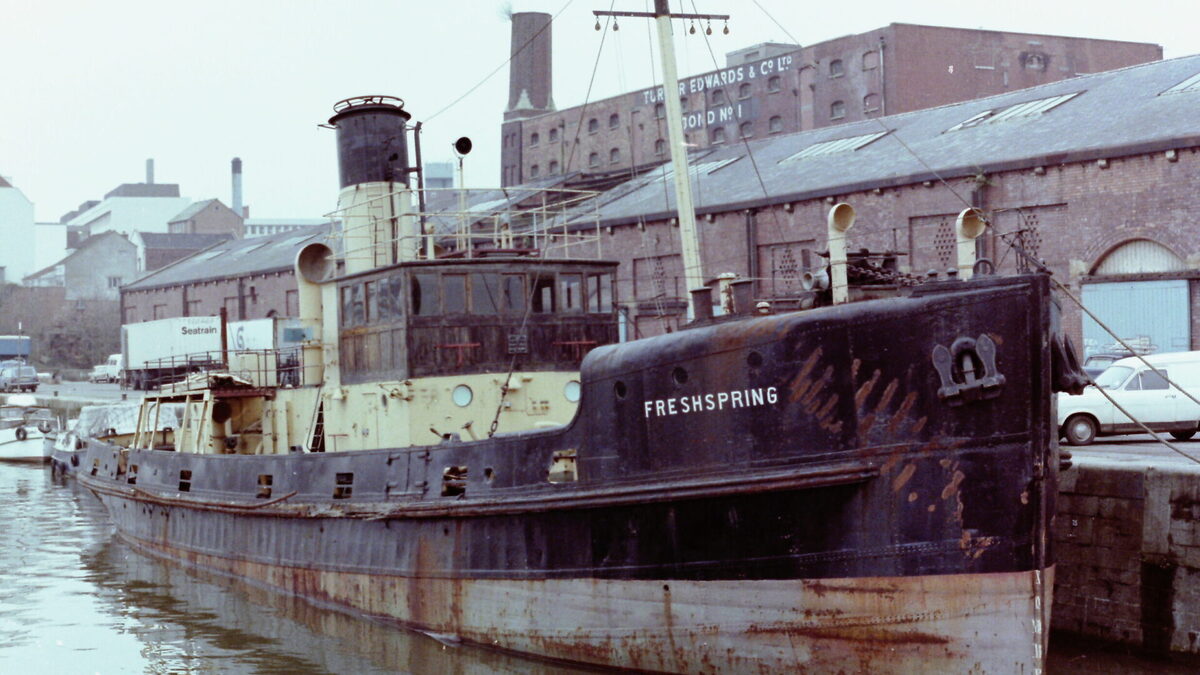
Discover a Historic Steamship of National Importance
Step aboard SS Freshspring, a remarkable steamship and the last surviving example of her kind. Built in 1946 by the Lytham Shipbuilding & Engineering Company for the Royal Fleet Auxiliary, she was one of 14 “Fresh” class water carriers constructed during and shortly after World War II. These versatile vessels supplied fresh distilled water to Royal Navy warships and supported them with emergency fire-fighting and salvage operations. Today, Freshspring is recognised as a vessel of National Importance, offering an extraordinary window into Britain’s maritime heritage.
Want to see our journey in action? – A video talk by John Puddy shares the remarkable story of SS Freshspring’s past, her restoration, and why she matters today.
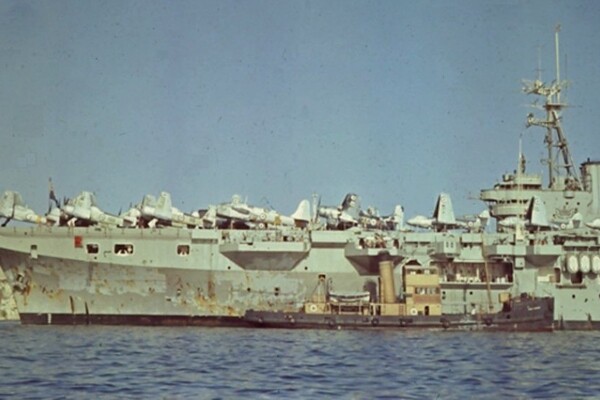
Historical Background
Launched on 15 August 1946 and completed by early 1947, SS Freshspring began her life of service with the Royal Fleet Auxiliary. Designed to meet the logistical needs of the Royal Navy, she played a vital role in sustaining warships with fresh water. Originally coal-fired, she was upgraded in 1956 to burn heavy fuel oil, which increased her efficiency and extended her usefulness. Her robust Scotch boiler, fitted with three oil burners, became a core feature of her operational performance.
Freshspring served primarily from her base in Malta for around 15–20 years before returning to the UK in 1967. There, she replaced her sister ship, Freshpond, and carried out duties at Devonport, the Clyde, and along the west coast of Scotland. In 1976, she was laid up in Gareloch and officially withdrawn from service the following year.

Service & Associations
Builder & Lineage
Freshspring was the last coal-fired water carrier built to Lloyd’s 100A1 standards by Lytham Shipbuilding & Engineering Co. in 1946. Today, she is the sole survivor of the Fresh-class ships, making her not only rare but also the final chapter of a proud Lancashire shipyard tradition.
Naval & Mercantile Service
First deployed to Malta’s naval anchorages, Freshspring later served the Port Auxiliary Service on Scotland’s Clyde and West Coast before being towed to Bristol for pioneering alternative-fuel trials. Each posting adds a layer to her life story, from frontline wartime support to peacetime innovation.
Documentation & Oral History
Extensive logs, original drawings, and firsthand recordings from crew members are preserved in our archive, offering unique insights into daily life aboard a mid-century steamship.

A Storied Past
After decades of active service supplying fresh water to Royal Navy warships, SS Freshspring was sold in 1979 to a Bristol-based company planning to explore alternative fuels. Those plans never materialised. Laid up on the River Severn at Newnham, she remained there for 30 years, forgotten, unmaintained, and exposed to harsh tides.
Thieves stripped her equipment, and the Severn Bore battered her hull. She slowly sank into the mud, her future uncertain.
Yet beneath the decay, SS Freshspring endured. Her engine room stayed remarkably intact, and her hull, though weathered, retained the strength of wartime construction. She stood as a testament to naval engineering: built to last.
By 2011, she was all but forgotten. But her survival hinted at the story she still had to tell—and the revival that lay ahead.
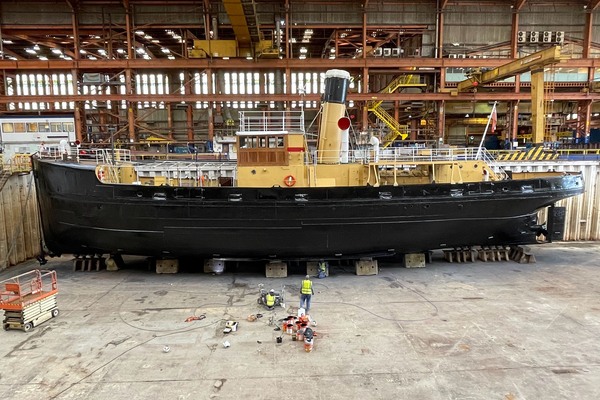
Preservation Efforts
Determined to save this historically significant vessel, a group of volunteers formed the Steamship Freshspring Trust in 2013. Their mission was simple but bold: to rescue, restore, and share SS Freshspring’s legacy. With support from the National Heritage Memorial Fund, she was towed to dry dock in 2016 for essential hull repairs and soon brought to her new home in Bideford, North Devon.
Since then, a growing team of volunteers has worked tirelessly to stabilise and repair the ship. They’ve restored decks, repainted her superstructure, improved visitor safety, and reopened her to the public. Their long-term ambition is to return Freshspring to working condition as a fully operational steamship, while ensuring she continues to serve as a vibrant and inclusive educational and heritage resource for schools, families, and communities.
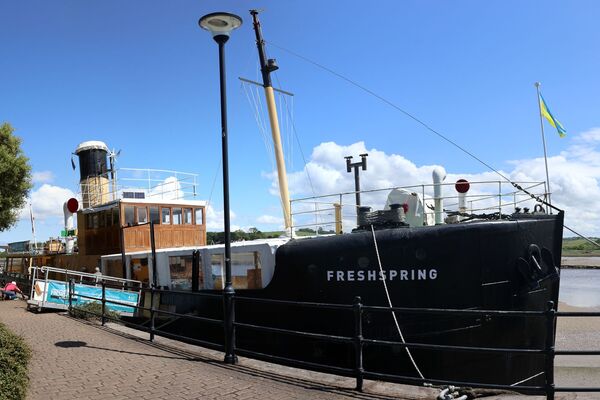
A Living Exhibit
Today, SS Freshspring is more than a preserved vessel—she is a unique floating museum, a classroom, and a window into maritime history. Visitors can explore her engine room, cabins, and decks while imagining the life of those who once served aboard. Her presence brings the age of steam to life for all ages.
She also serves as a learning hub for STEAM subjects, providing hands-on experiences for students and families. Activities in engineering, design, and maritime heritage help young people connect classroom learning with real-world applications. With new displays, improved facilities, and community events, the ship is alive with stories and learning opportunities.
➡️ Plan your visit and come aboard to explore history hands-on.
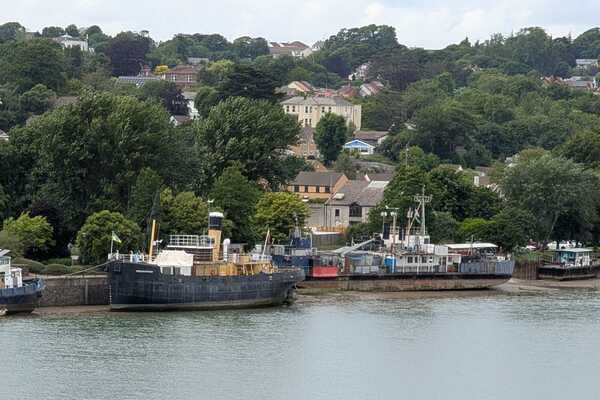
Looking Ahead
As restoration progresses, SS Freshspring enters a bold new chapter. Plans include reactivating her steam engine, expanding her onboard displays, and reaching broader audiences through mobile exhibits and digital media. These initiatives will transform her from a static museum into a working maritime heritage centre.
The Trust also aims to deepen engagement with schools, training providers, and youth organisations. Through tailored visits, apprenticeships, and hands-on workshops, the ship will help nurture future engineers, historians, and caretakers of our shared past. SS Freshspring will continue to be a dynamic and evolving platform for education, inspiration, and community connection.
➡️ Explore our education programme to see how we’re inspiring young minds.


